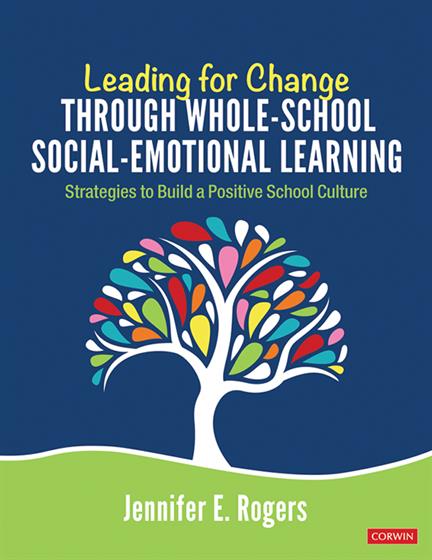Preface
Acknowledgments
About the Author
Introduction: Using Social-Emotional Learning to Make Your School More Positive and Productive
What Does Social-Emotional Learning Have to Do With Systems Change?
Fair Warning: The Challenge Of Systems Change
Chapter 1: Why Now?
Mental Health Of Our Students
Adverse Childhood Experiences
The Changing Dynamics Of Our Classrooms
Burnout And Stress Of Teachers
Prevention
Outcomes
The Who Is You
The First Step—Self-Care: Putting Yourself on the To-Do List
Practitioner’s Voice
Reflection Questions
Resources
Chapter 2: Whole-School Social-Emotional Learning—Research on SEL
What Is Social-Emotional Learning?
SEL Core Competencies
Powerful Evidence Supporting The Impact Of Enhancing Students’ Social-Emotional Skills
Multitiered Systems Of Support And Sel: Universal Support For All Students
SEL and School Culture
Practitioner’s Voice
Resources
Reflection Questions
Chapter 3: Strategy #1: Identify Your Why
Inspiration Leads to Action
Beliefs as Barriers to Action
The Mascot, the Carrot, and the Competition
Why Is the Driver for Who, What, When, and Where
Practitioner’s Voice
Chapter 4: Strategy #2: Adopt A Framework
Framework, Model, and Intervention, Oh My!
Read the Directions Before Application: Choosing a Framework
The Importance of Process When Choosing a Framework
Chapter 5: Strategy #3: Do Your Detective Work—Data Collection and Data Analysis
Ask Questions
Using Data Thoughtfully
Large Data Sets: Needs Assessment, Universal Screeners, Skill Assessments, and Surveys
In the Moment: Data Collection
How Do We Gather Data About Our School and Community?
Developing Your Own Accountability Tool
Practitioner’s Voice
Resources
Reflection Questions
Chapter 6: Strategy #4: Work With Others to Develop a Vision to Guide Change
Vision Statement
Vision for Leadership
Your School Leaders—Are They on Board?
Vision Standards
Practitioner’s Voice
Resources
Reflection Questions
Chapter 7: Strategy #5: Understand the Politics of Your Workplace
Understanding the Politics of Your Workplace (Yes, Even In Kindergarten)
Social Network Theory
History of Interventions
Importance of Who Is on the Team
The “What” of School SEL Teams
Making Working Together Work
More Issues
Things to Consider When Hiring an Expert
Practitioner’s Voice
Resources
Reflection Questions
Chapter 8: Strategy #6: Develop an Action Plan for Implementation
Making Stuff Happen—It’s All About a Plan
You Say You Want an Interventions
Action Planning
Practicing SEL
What Is Loose and What Is Tight?
What Do We Want? Change! When Do We Want It? Should’ve Happened Yesterday!
Practitioner’s Voice
Resources
Reflection Questions
Chapter 9: Strategy #7: Invest in Your Infrastructure
What Is Infrastructure And Why Do We Need It?
Fidelity of Implementation
Building Capacity
Empowering Student Voice
Parent/Family Involvement
Building Community Understanding
Infrastructure Issues: The Leadership Merry-Go-Round
Practitioner’s Voice
Resources
Reflection Questions
Chapter 10: Strategy #8: Plan for Resistance to Change
Resistance to Change
Challenge Scenarios
Practitioner’s Voice
Resources
Reflection Questions
Chapter 11: Strategy #9: Assess Your Outcomes
Gold Standard for Change: The “Fire Drill Effect”
Big Question: Did Anything Change for the Better?
SEL Intervention Outcomes
Measuring Your SEL Implementation
Be Sensitive to Outcome Overload
Overall Goal of Assessing Outcomes: Improving Systemic Integration and Sustainability
Practitioner’s Voice
Resources
Reflection Questions
Chapter 12: Strategy #10: Fill in the Gaps of Your Foundation
Filling in Gaps
Revisiting the Past: How Is Your Framework Meeting Your Needs?
Celebration Time! Okay, Now Back to Work
Revise and Resubmit: The Evolution of Your Intervention
Practitioner’s Voice
Resources
Reflection Questions
Chapter 13: Conclusion
A Final Message for You: The Agent of Change
Appendix 1: SEL and System Change Strategies Rubric
Appendix 2: Professional Development Exit Ticket
Appendix 3: Figures and Graphics
References
Index
Resources
Reflection Questions
Practitioner’s Voice
Resources
Reflection Questions



